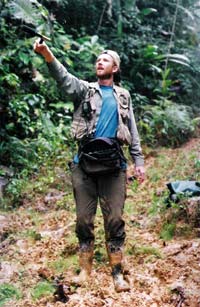Who Sings First During the Dawn Chorus—and Why?
By Clara McCarthy; Photograph by Chris Pallis
January 15, 2009
The magic of the dawn chorus—that splendid concentration of bird song at first light during the breeding season—has been studied extensively in temperate areas of North America, but hardly at all in the tropics. Why do birds sing so dramatically at dawn? Is it because sound travels best at this time? Do the healthiest potential mates have extra energy stores that they can use before embarking on another day of foraging? Do they optimize their daily time budget by getting much of their singing accomplished before light levels are adequate for foraging?
Karl Berg studied the dawn chorus in a tropical forest in Manabi, Ecuador, to find some answers to these questions. He and his team recorded bird song from 57 species during late January and February, the breeding season for many local songbirds. They found that each species started singing at a specific time relative to first light, a phenomenon also found in temperate ecosystems. For passerines, this time is related to each species’ characteristic foraging height and its eye size. Species that forage higher in the canopy or have larger eyes sang earlier than others.
This suggests that light levels are responsible for the timing of singing. Leaves and branches shade out lower levels of the forest so that the forest floor takes longer to brighten than the canopy. Birds with different eye sizes perceive light levels differently at the same height, because larger eyes gather more light than smaller ones. At some point around dawn, each species may have enough light to see predators and competitors, before there is sufficient light to effectively forage for food. It may sing at its maximum rate for the day until the point when there is enough light to forage.
This study appeared as a 2006 article in Proceedings of the Royal Society: B, as well as a research highlight in Nature.
Originally published in the January 2009 issue of BirdScope.

All About Birds
is a free resource
Available for everyone,
funded by donors like you
American Kestrel by Blair Dudeck / Macaulay Library
